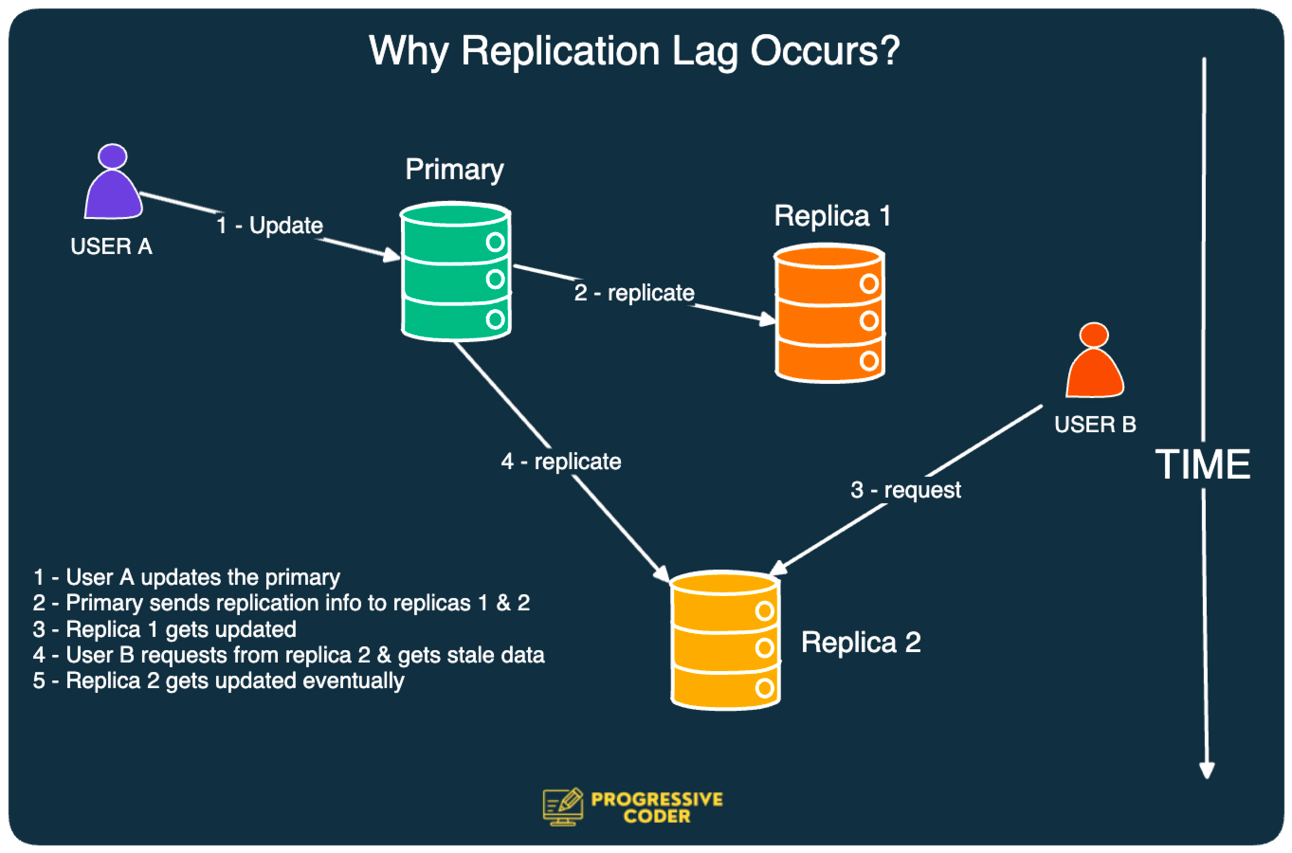What is replication lag and what impact it causes on overall database?
Replication lag refers to the delay between when a change (write operation) is made on the primary (master) database and when that change is applied to the replica (slave) database.
It occurs in database replication systems (especially in asynchronous replication) due to factors such as network latency, the processing time required to apply changes, and the system's ability to handle the replication workload.
What Causes Replication Lag?
Network Latency:
Delays in data transfer over the network between the primary and replica.
Write Volume:
The primary may be processing a large number of writes, and the replica may struggle to keep up with these changes.
Slow Replica Processing:
The replica may be under heavy load, leading to delays in applying the changes from the binary logs (or other replication logs).
Resource limitations on the replica (e.g., CPU, memory, disk I/O) can slow down replication.
Large Transactions:
If the primary executes large transactions or bulk inserts/updates, the replica may take time to catch up.
Longer Log Processing Times:
The replica may need more time to process large or complex queries, particularly if they affect many rows.
Garbage Collection and Disk I/O:
Background tasks like garbage collection or disk I/O contention may delay the replication process.
Replicas Behind in Synchronization:
When a replica falls too far behind (for example, due to network failures or maintenance), it may take longer to catch up with the primary.
Inconsistent Configuration:
The replica might not be configured optimally (e.g., incorrect buffer sizes, insufficient memory allocation), causing it to lag behind.
Impact of Replication Lag
Data Inconsistency
Temporary Inconsistency: If the replica is used for read queries (as part of a read replica setup), replication lag can cause outdated data to be served to the application. For example, a read query on the replica may return stale data that doesn’t reflect the latest changes made on the primary.
Out-of-Order Reads: If there’s heavy read traffic on the replica, users may see data that doesn't correspond to the most recent updates made on the primary, potentially leading to inconsistency issues.
Performance Degradation
Read Latency: Applications relying on replicas for read queries may experience slower response times if the replica is lagging, as the replica might take longer to process the queued-up replication events.
Overloaded Primary: In systems where the primary serves both read and write traffic, a lagging replica can place additional strain on the primary to handle read requests, leading to performance bottlenecks.
Inaccurate Reporting & Analytics
In scenarios where the replica is used for reporting or analytics, a lag can result in inaccurate reports that don’t reflect the most recent data. This can impact decision-making, especially in real-time applications.
Transactional Integrity
If the replica is used for transactions (e.g., failover or disaster recovery), replication lag can result in data inconsistencies during failover. If a failover occurs and the replica is out of sync with the primary, users may experience lost data or transaction rollbacks.
Delayed High Availability (HA)
Replication lag impacts the effectiveness of high availability configurations, such as automatic failover. If the replica is lagging behind, it may not contain the latest committed data, and failing over to the replica may result in data loss or inconsistency in the application state.
Increased Maintenance Complexity
Long replication lag can indicate a need for more robust monitoring and maintenance to ensure that replicas are healthy and synchronized with the primary. It may require database tuning, optimizing queries, or scaling the replica infrastructure.
Mitigating Replication Lag
Use Synchronous Replication:
In synchronous replication, the primary waits for acknowledgments from the replica(s) before confirming the transaction, which ensures both the primary and replica are always in sync. However, this can increase latency and reduce throughput due to waiting for replicas to apply changes.
Improve Replica Performance:
Ensure the replica has sufficient resources (CPU, memory, I/O throughput) to handle incoming replication events.
Optimize replica configuration, including the size of the replication buffers, disk I/O settings, etc.
Asynchronous Replication with Monitoring:
In systems that use asynchronous replication, you can implement a monitoring system to track replication lag and set alerts when lag exceeds acceptable limits. This helps catch issues early before they affect the application.
Optimize Primary Database:
Optimize write-heavy workloads on the primary (e.g., batching transactions) to reduce the load on the replication pipeline.
Use write-optimized databases or partitioning schemes to distribute writes efficiently.
Replicate Only Necessary Data:
Use partial replication or filter replication to only replicate essential data to reduce the load and ensure faster replication.
Increase Network Bandwidth:
Use faster network connections between the primary and replica to reduce latency in data transfer.
Replica Scaling:
Add more replicas to distribute the read load, which can reduce the strain on individual replicas and help mitigate lag.
Periodic Resynchronization:
If replication lag is significant, periodically resynchronize replicas with the primary by performing a full sync (e.g., using a database dump or backup).
Summary
Replication lag is the delay between changes made on the primary database and their application on the replica.
Impacts include data inconsistency, performance degradation, inaccurate reporting, transactional integrity issues, and delayed high availability.
Mitigating lag involves optimizing replica and primary performance, using monitoring, and possibly considering synchronous replication or improving network infrastructure.
Replication lag is a common challenge in distributed databases, but with appropriate monitoring and optimization, its impact can be minimized.
source:-wikipedia



Asynchronous Replication is primarily preferred and mostly used.